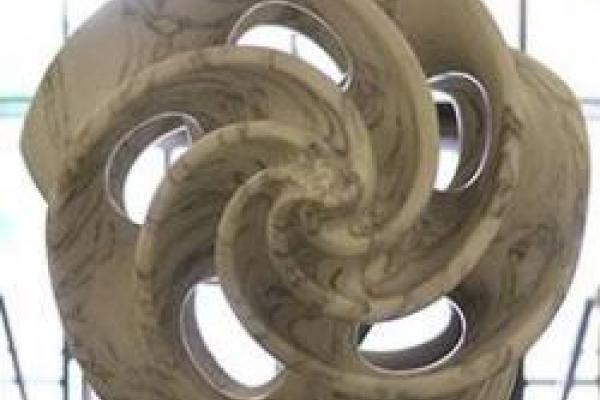
December 1, 2015
12:30 pm
-
1:25 pm
CH 240
Add to Calendar
2015-12-01 13:30:00
2015-12-01 14:25:00
Special Lecture - Henry Segerman
Title: Design of 3D printed mathematical art Speaker: Henry Segerman, Oklahoma State University Abstract: When visualising topological objects via 3D printing, we need a three-dimensional geometric representation of the object. There are approximately three broad strategies for doing this: "Manual" - using whatever design software is available to build the object by hand; "Parametric/Implicit" - generating the desired geometry using a parametrisation or implicit description of the object; and "Iterative" - numerically solving an optimisation problem. The manual strategy is unlikely to produce good results unless the subject is very simple. In general, if there is a reasonably canonical geometric structure on the topological object, then we hope to be able to produce a parametrisation of it. However, in many cases this seems to be impossible and some form of iterative method is the best we can do. Within the parametric setting, there are still better and worse ways to proceed. For example, a geometric representation should demonstrate as many of the symmetries of the object as possible. There are similar issues in making three-dimensional representations of higher dimensional objects. I will discuss these matters with many examples, including visualisation of four-dimensional polytopes (using orthogonal versus stereographic projection) and Seifert surfaces (comparing my work with Saul Schleimer with Jack van Wijk's iterative techniques). I will also describe some computational problems that have come up in my 3D printed work, including the design of 3D printed mobiles (joint work with Marco Mahler), "Triple gear" and a visualisation of the Klein Quartic (joint work with Saul Schleimer), and hinged surfaces with negative curvature (joint work with Geoffrey Irving).
CH 240
OSU ASC Drupal 8
ascwebservices@osu.edu
America/New_York
public
Date Range
2015-12-01 12:30:00
2015-12-01 13:25:00
Special Lecture - Henry Segerman
Title: Design of 3D printed mathematical art Speaker: Henry Segerman, Oklahoma State University Abstract: When visualising topological objects via 3D printing, we need a three-dimensional geometric representation of the object. There are approximately three broad strategies for doing this: "Manual" - using whatever design software is available to build the object by hand; "Parametric/Implicit" - generating the desired geometry using a parametrisation or implicit description of the object; and "Iterative" - numerically solving an optimisation problem. The manual strategy is unlikely to produce good results unless the subject is very simple. In general, if there is a reasonably canonical geometric structure on the topological object, then we hope to be able to produce a parametrisation of it. However, in many cases this seems to be impossible and some form of iterative method is the best we can do. Within the parametric setting, there are still better and worse ways to proceed. For example, a geometric representation should demonstrate as many of the symmetries of the object as possible. There are similar issues in making three-dimensional representations of higher dimensional objects. I will discuss these matters with many examples, including visualisation of four-dimensional polytopes (using orthogonal versus stereographic projection) and Seifert surfaces (comparing my work with Saul Schleimer with Jack van Wijk's iterative techniques). I will also describe some computational problems that have come up in my 3D printed work, including the design of 3D printed mobiles (joint work with Marco Mahler), "Triple gear" and a visualisation of the Klein Quartic (joint work with Saul Schleimer), and hinged surfaces with negative curvature (joint work with Geoffrey Irving).
CH 240
America/New_York
public
Title: Design of 3D printed mathematical art
Speaker: Henry Segerman, Oklahoma State University
Abstract: When visualising topological objects via 3D printing, we need a three-dimensional geometric representation of the object. There are approximately three broad strategies for doing this: "Manual" - using whatever design software is available to build the object by hand; "Parametric/Implicit" - generating the desired geometry using a parametrisation or implicit description of the object; and "Iterative" - numerically solving an optimisation problem.
The manual strategy is unlikely to produce good results unless the subject is very simple. In general, if there is a reasonably canonical geometric structure on the topological object, then we hope to be able to produce a parametrisation of it. However, in many cases this seems to be impossible and some form of iterative method is the best we can do. Within the parametric setting, there are still better and worse ways to proceed. For example, a geometric representation should demonstrate as many of the symmetries of the object as possible. There are similar issues in making three-dimensional representations of higher dimensional objects. I will discuss these matters with many examples, including visualisation of four-dimensional polytopes (using orthogonal versus stereographic projection) and Seifert surfaces (comparing my work with Saul Schleimer with Jack van Wijk's iterative techniques).
I will also describe some computational problems that have come up in my 3D printed work, including the design of 3D printed mobiles (joint work with Marco Mahler), "Triple gear" and a visualisation of the Klein Quartic (joint work with Saul Schleimer), and hinged surfaces with negative curvature (joint work with Geoffrey Irving).
